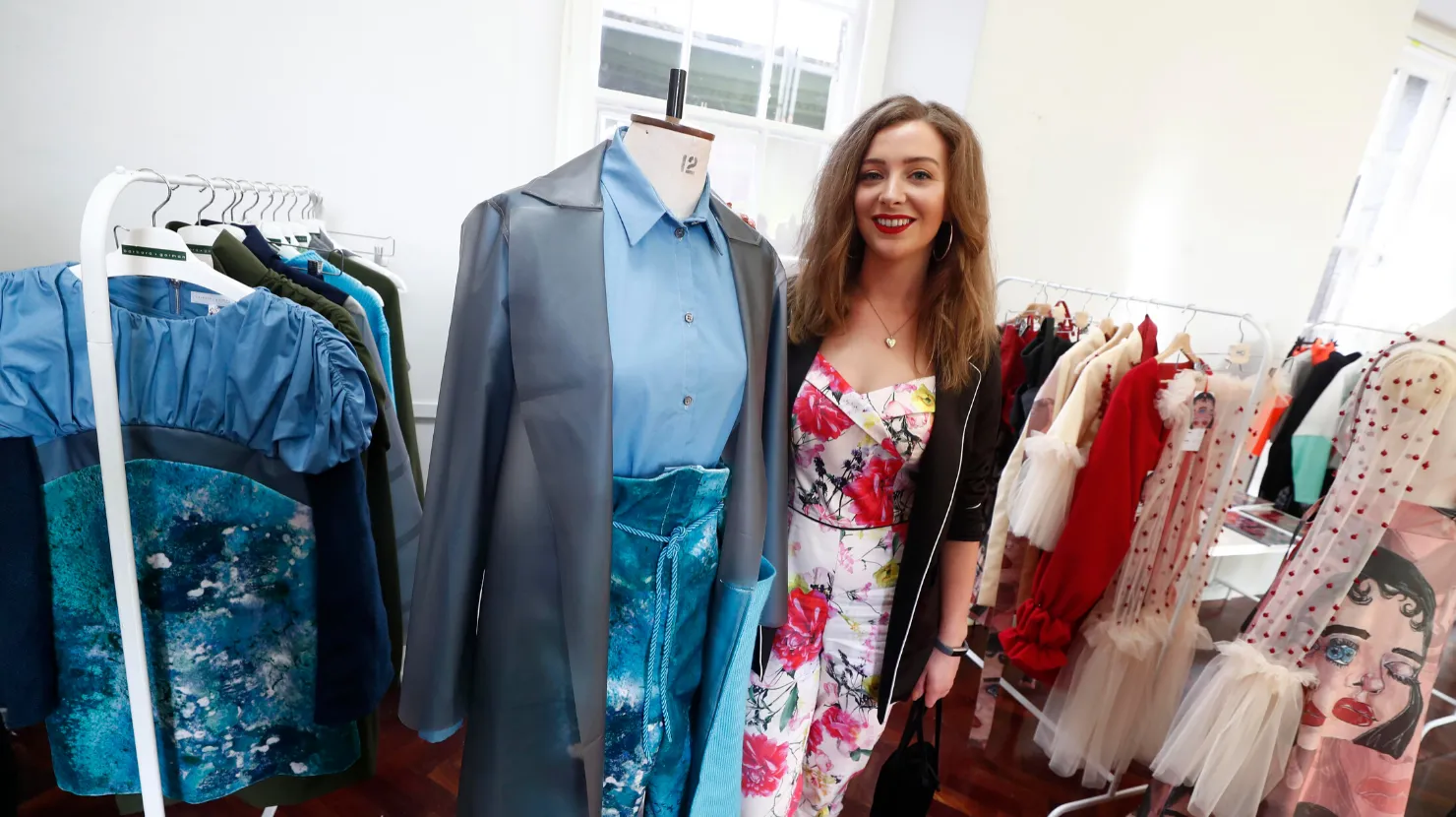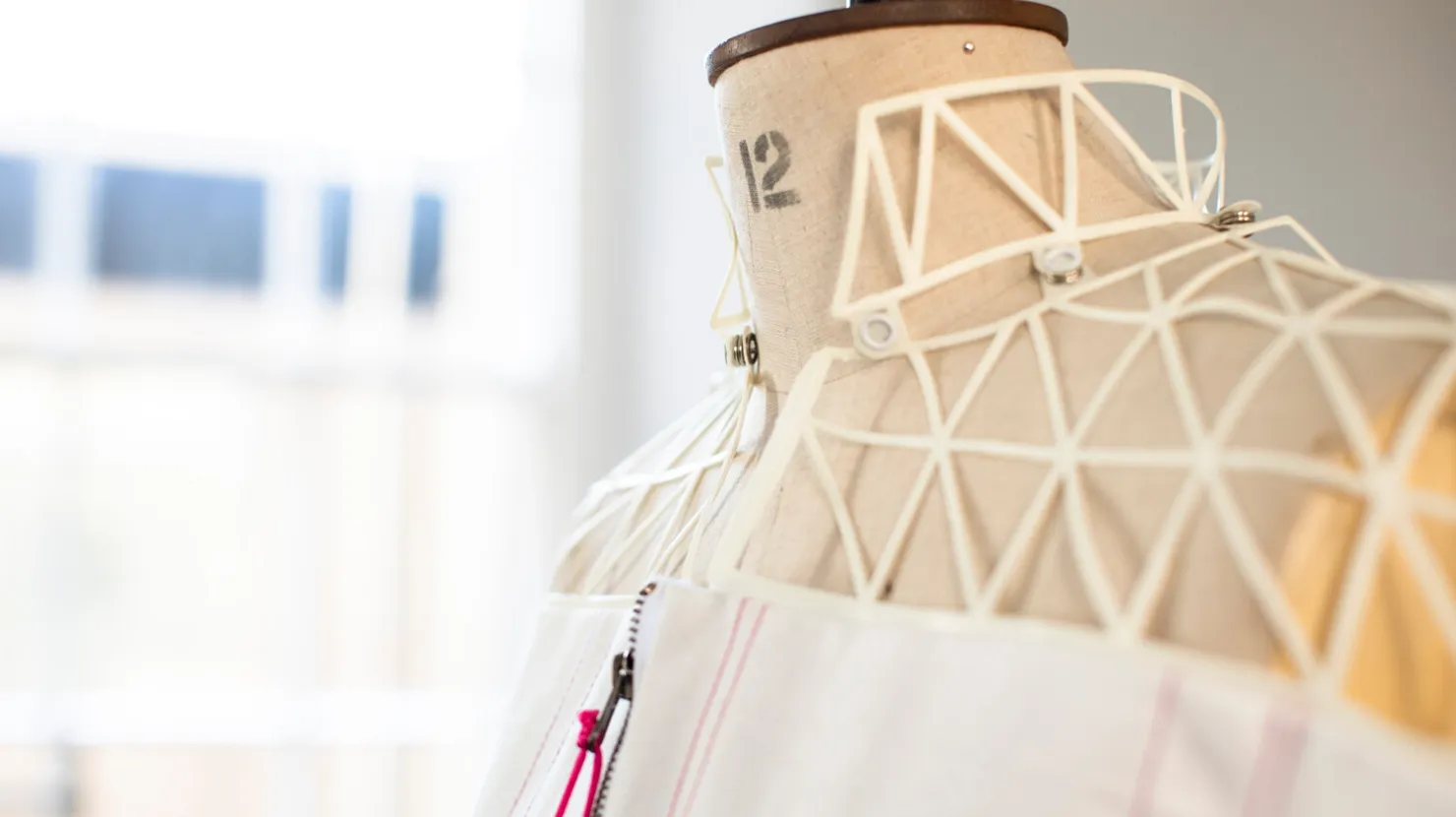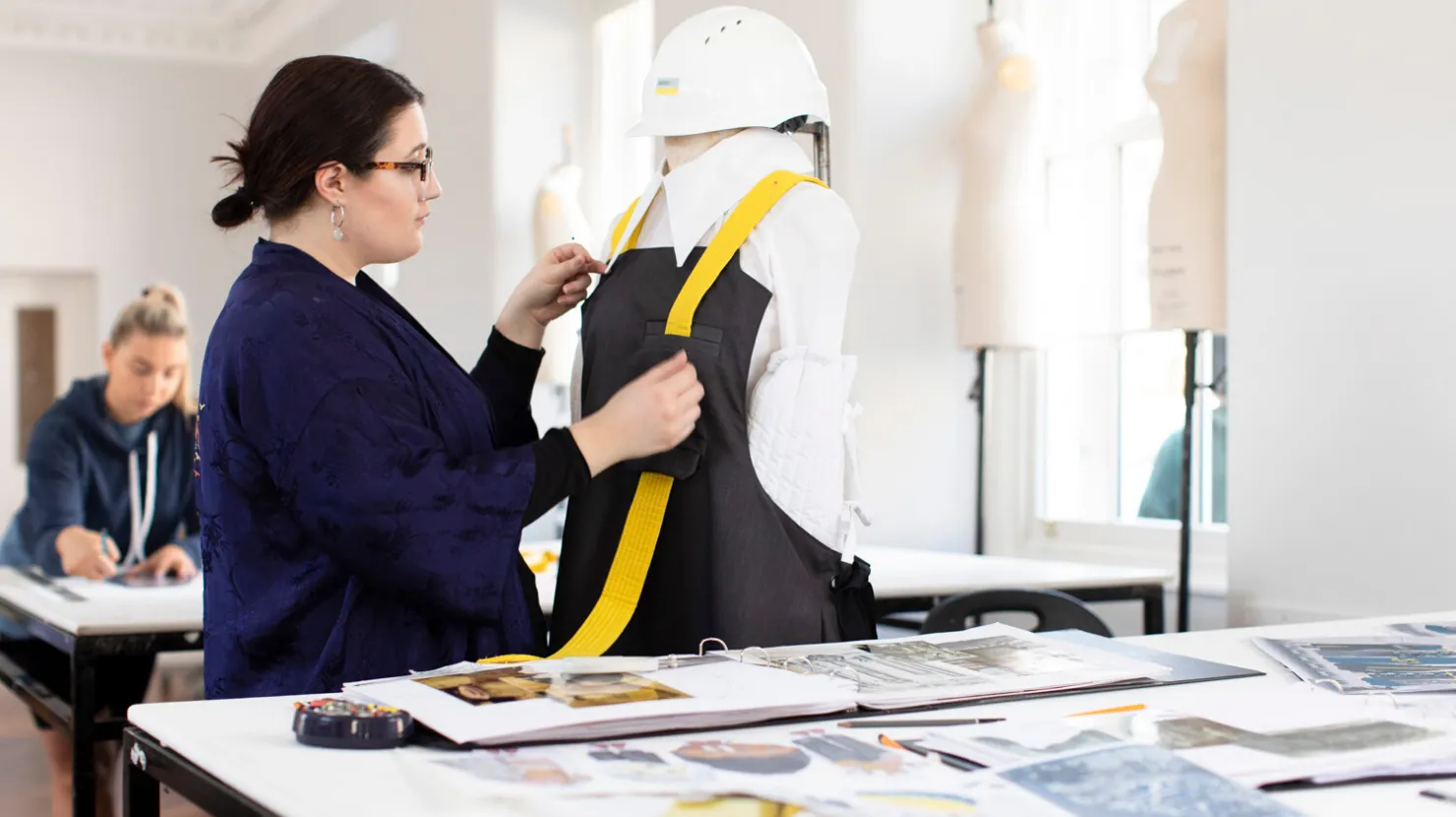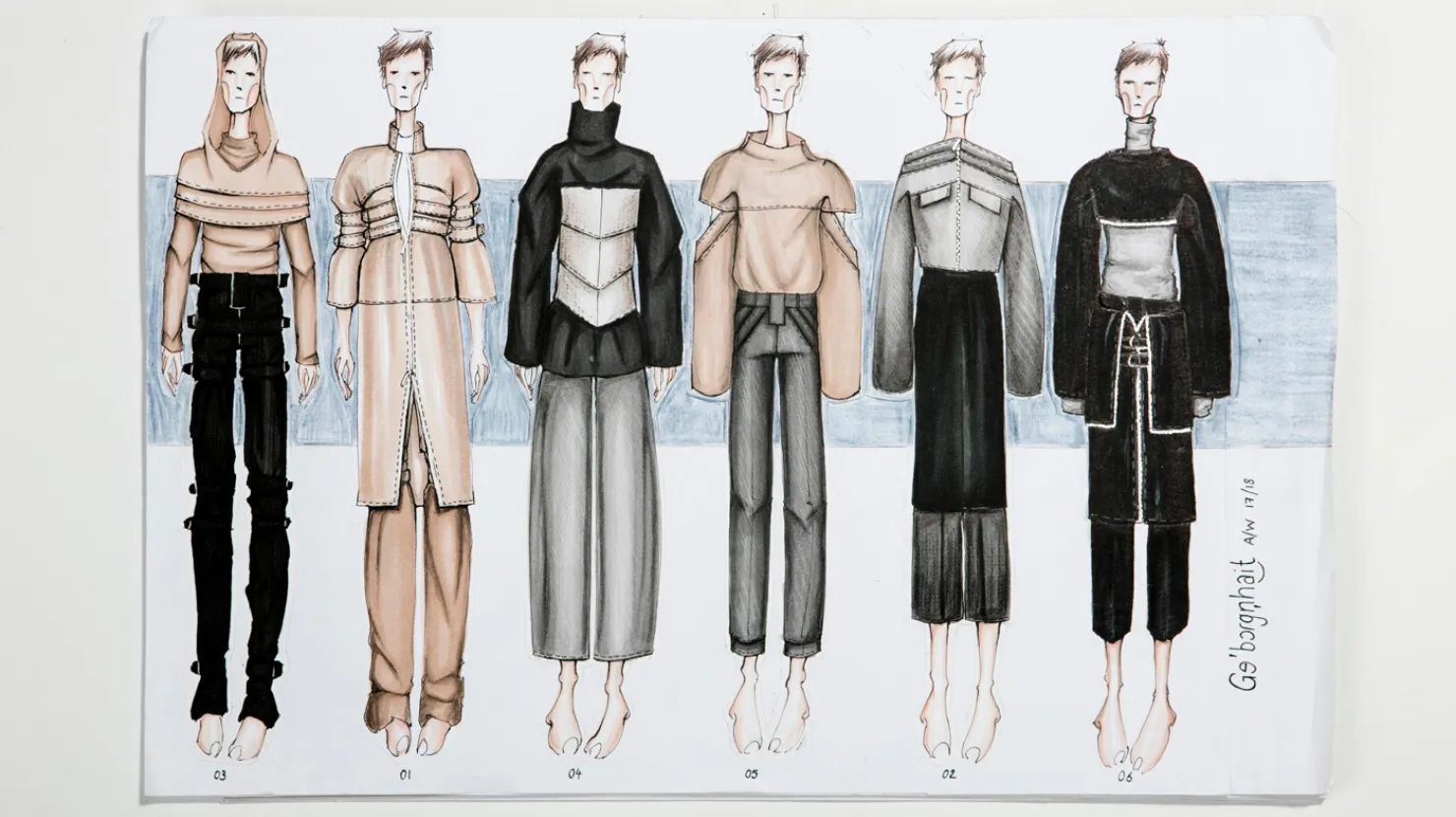BA in Fashion Design

Course Overview
Cultivate your creativity and tailor your future in fashion.
Step into the world of fashion with our BA in Fashion Design, a three-year Level 7 degree that blends creativity, technical skills, and business insight. Designed for aspiring designers, this three-year, full-time course offers hands-on industry experience and prepares you for a wide range of roles across the fashion sector.
Ready to make your mark? Discover what's possible by checking out the Fashion students’ work from Griffith Creative 2025.

Why Study Fashion Design at Griffith College?
- Design and produce your own fashion collection from concept to catwalk.
- Learn from 100% continuous assessment — no written exams.
- Showcase your work at Griffith’s annual Creative Week.
- Join a course with award-winning graduate work recognised across the industry.
- See alumni stocked at Brown Thomas Create, Havana, Om Diva and more.
- Gain practical skills in garment construction and pattern development.
- Build strong branding, marketing, and entrepreneurship foundations.
- Explore your personal design identity through hands-on modules.
- Prepare for careers in design, buying, forecasting, merchandising, and beyond.
- Learn how to work with international suppliers and production teams.
Course Highlights
- Small Class Sizes, Big Support
Get personalised feedback and mentorship in a close-knit, collaborative environment. - Hands-On Studio Experience
Develop practical skills in fully equipped design studios. - Learn from Industry Professionals
Be taught by designers, makers, and creatives with real-world experience. - Showcase Your Work at Griffith Creative Week
Present your final-year projects to industry, peers, and the public. - Real-World Inspiration
Explore exhibitions, studios, and fashion industry briefs to fuel your creativity.
Fashion Internships and Careers
Each year, Griffith College students and graduates secure internships with leading fashion companies in Ireland and abroad. Our alumni have gone on to work at:
Avoca, Caroline Kilkenny, CVUK London, Ella Boo, Ellis Bridal, Emmett Equestrian, , Filmbase, Gareth Pugh, GW Global Trading, Helen Steele , Helen Mcalinden, Home Studios London, Hybrid Fashion, Joanne Hynes Design, Kathy De Stafford, Louboutin, Louis Copeland, Louis Vuitton, Mariana Jungmann, Mirjam Rouden, Native Clothing Designs, Nicole Farhi, Percival, Primark , Reiss, Rick Owens, Simone Rocha, Soho Apparel, Styletex and Vivienne Westwood.
Questions? Have a look at our FAQ section.
Intake Dates
- Dublin - Full-Time - September 2026
Are you applying through the CAO?
Check out our CAO HUB for everything you need to know about applying through the CAO!
Course codes
- Dublin: GC495

My favourite memory from Griffith is definitely the fashion design process. I love seeing how little sketches at the very start can evolve into something like your own collection. I also loved the people I met and the teachers.
Fashion Design

I really love the pattern classes with Anne-Marie. It was a great experience, and the whole vibe in the classroom was really friendly.
Fashion Design
Course Details
The BA in Fashion Design prepares students for careers in fashion. The programme emphasises project-based learning, requiring learners to experiment and innovate in order to create imaginative and realistic design solutions. Learners are immersed in the fashion industry from traditional methods of tailoring, draping, and embellishment techniques to fashion illustration and computer-aided design (CAD) skills. The fashion design modules allow learners to explore a personal design style; from idea generation, design development, and pattern creation through to garment construction using contemporary production techniques. Graduates of the programme are working as assistants in fashion design and trend forecasting companies.
Graduates of the BA in Fashion Design may also progress to the final stage of the related BA (Hons) in Fashion Design, either directly or a later time of their choosing.
Year One
Exploring Art & Design Concepts Through Studio Projects
Introduction to Design Practice and Process
Creative Problem-Solving through Design Projects
This module teaches the learner to assemble relevant information and research to assist in idea generation to develop and create original images and to observe, record, and respond, exploring a wide range of art and design practices. It also teaches the learners to apply visual methods, communicate ideas via free-hand drawing, technical drawing, and graphic arts, and identify primary and secondary visual research methodologies. Projects cover fine art, print, fashion, interiors, and graphic design.
Foundations of 2D Drawing and Sketching
Creative Techniques for 2D Visual Storytelling
Hand-Drawn Visual Communication in Design
Introduction to Image Making and Photography
Sketching and Rendering Techniques for Design
This module teaches the learner to observe, record, and analyse the physical environment, visually explaining concepts, ideas, and three-dimensional space through sketching and applying sketching as a tool in the design process. It also teaches the learner still life, life drawing, fashion drawing, interior drawing, illustration and animation drawing skills. It introduces the learner to photography.
Introduction to Bitmap, Publishing and Vector Graphics
Fundamentals of Digital Design Tools
Digital Design Applications and Techniques
This module introduces learners to the Bitmap, Publishing, and Vector Graphics Software to a required degree of proficiency.
Understanding Design Principles and Elements
Foundations of Design Thinking
Applying Design Theory in Practice
This module teaches the learner to recognise, understand, and communicate a specific design terminology in relation to design principles and their application, using conceptual themes in the creation and use of shapes and volumes.
Advanced Design Projects and Applications
Building on Design Concepts and Techniques
Innovative Solutions through Creative Studio Projects
Portfolio Development and Professional Practice
This module teaches the learner to understand the importance of contextual references, to solve problems by applying knowledge and experience, to be able to initiate research and independently select media, and to present a final major project and portfolio of work. Projects cover photography and a final project in either fashion, interior, or graphic design.
Exploring Spatial Concepts through Hand-Drawing
Mastering 3D Sketching and Rendering Techniques
Advanced Freehand Drawing for 3D Design
This module teaches the learner to draw/trace and colour optical illusions, to draw simple sketches using grid paper, to render sketches with pencils and/or felt markers as a means of enhancing sketches, to use one, two, and three-point perspective to sketch room interiors adding colour, to draw/trace orthographic views of simple models on grid paper, to complete orthographic views from 3D sketches, and to trace/redraw isometric views on grid paper by interpreting 2D drawings.
Advanced Bitmap, Publishing and Vector Graphics Design Software Techniques
Specialised Applications of Digital Design Tools
Digital Design Strategies and Workflows
This module introduces learners to Graphic Design Publishing Software and Video Editing Software” to a required degree of proficiency. It introduces the learner to use image manipulation and to enhance their design skills using vector-based graphics applications and composite layered image making. The module also integrates the graphic image with page layout and designing visual documents for web and print.
Exploring Visual Culture and Its Impact on Design
Critical Analysis of Visual Culture and Design
Theoretical Foundations of Design and Visual Culture
The module aims to enable learners to compare and contrast different historical periods and styles in art and design, and understand their evolution through time. It will also develop the learner’s skills in the visual analysis that will be required in other modules within the programme. Learners will be introduced to key historical styles and periods in European art and design from Neoclassicism (c. 1790) up to early Modernism (c. 1914). Learners will also be supported to develop their academic referencing and essay research skills.
Year Two
In this core design module, learners develop drawing skills and appropriate design research methods to develop original concepts to inspire personal creative ideas to drive collections. Project briefs introduce various stages of design, including research, concept, design development, selection, and presentation skills. As learners start to understand the process necessary to create an original design, they gain confidence in their design, selection, and presentation skills. Selected designs are realised in Garment Construction 1.
In this module, learners acquire skills to translate their designs from a specification sheet to a final complete garment using industry-standard pattern drafting and basic garment production techniques.
The module advances learners skills in three design communication tools and printing. The learning outcomes of this module underpin a lot of the learning to be applied in other modules and so contribute to most of the intended programme learning outcomes.
This module gives the learner a broad understanding of how the fashion industry operates by looking at the sectors in the fashion industry, from couture to mass production, the schedule, processes, and roles involved. Learners to gain an understanding of the social and environmental impact of the fashion industry, the problems and challenges. The module highlights how ethical and circular design is now a driving force for most brands.
This module traces the evolution of historical fashion in the social, economic, and political contexts from the mid-nineteenth century up to the current time. It focuses on the most important couturiers that were active from c. 1850, describing how their key innovations were made and worn and their contribution to the history of haute couture. The module introduces academic referencing, essay research, structure, and writing skills, enabling learners to establish their own voice in an academic environment.
In this core fashion design module, learners work through project briefs that embed much of the design theory and drawing skills explored in semester 1 and understand the process necessary to create original design. Learners gain confidence in design development through drape and presentation skill-builds. Learners acquire creative awareness, select designs, and define design detail to translate to specification sheets for realisation in Garment Construction 2.
In this module, learners achieve competency and confidence to create creative pattern and assemble garments using appropriate industry sewing techniques and materials. Learners acquire skills to create garments using production techniques, demonstrating readiness to progress to tailoring.
This module teaches the learner a variety of advanced bitmap and vector graphics editing skills and how to apply practical desktop publishing solutions. It also teaches the learner to creatively apply and communicate effectively graphic techniques employing the use of a grid and typography, apply the technical skills for print production, and format a design and layout project or digital drawing for print.
This module provides the learner with a broad understanding of the theory and application of textiles to garment design. Both practice and theory are explored so learners advance their ability to identify fibres and fabrics and understand the importance of the application of appropriate materials to design
The module gives learners a broad understanding of historical, cultural, social, and political contexts in which modern and postmodern design evolved. The learning outcomes of this module underpin some of the learning to be applied in other modules (Visual Culture and Theory; Design Futures; Dissertation) and so contribute to some of the intended programme learning outcomes.
Year Three
In this core fashion design module, learners gain specialist knowledge of sectors within the fashion industry and design two collections. Learner’s practice advanced and creative 2D and 3D design development draping on the stand to achieve a higher level of creativity and fluent silhouette development. Projects involve authentic learning to equip learners with knowledge of fashion industry sectors to facilitate future employment opportunities. Learners translate detailed design to specification with appropriate material considerations and identify production techniques for realisation in Garment Construction 3 and 4.
In this module, learners build on the basic pattern drafting skills introduced in the first year and acquire more advanced technical tailoring pattern drafting and sewing skills required to support Fashion Design 3 and 4 projects. The curriculum is also structured to advance exploration of creative drapes and sustainable design solutions. Draping on the stand builds confidence and fluency of design, moving toward experimentation with more advanced pattern drafting.
Fashion illustration enables the learner to further develop their freehand fashion drawing skills and gain digital fashion drawing skills, learning to effectively communicate design and meaning. Learners produce a digital vector library of technical flat garment drawings, symbols, and brushes for design details; developing a portfolio of both freehand and digital fashion figure poses and art forum fashion illustrations.
The Design Futures module provides learners with a broad understanding of theoretical contexts of major movements in art, design, and visual culture—both historical and contemporary. This module provides crucial context for creative activity, working in tandem with practical modules by exposing learners to major concepts, structures, thinkers and practitioners
This module addresses key factors to be considered when starting a small business, entrepreneurial theories, business concepts through planning a feasibility project, and a lean start-up style canvas, and customer analysis.
This core fashion design module builds a high level of creative awareness, design fluency, and industry processes and broadens the learner’s design experience and skill set by introducing areas of specialist knowledge with workshops that involve trend research, planning and forecasting, knit and print design, and fashion illustration. These areas require industry-specific research, advanced design, new illustration techniques, and visual presentation skills appropriate to the trend forecasting sector expectations. Learners must achieve fluent design competencies and a portfolio demonstrating visual literacy, industry expertise, and readiness to progress to the final stage of the level 8 programme.
In this module, learners create their Mini Collection, as designed in Fashion Design 3, and explore advanced creative pattern drafting techniques required to create their designs. Sewing workshop demonstration: using industry equipment, learners develop a range of advanced sewing and finishing skills with confidence. Learners are prepared to progress to employment or to the final stage of the level 8 programme when advanced pattern drafting and garment construction are required to execute a degree collection meeting industry standards.
This module enables the learner to develop skills in the use of the digital camera for photography and video and explore industry standards in this area. It introduces the basic principles of photography and video, with the emphasis being on images within their design studio practice.
This module covers the nature and role of marketing in a design business. They learn to identify the environmental variables, segmentation, targeting and positioning, marketing mix for a creative brand, and how to create a marketing plan.
In support of Fashion Design 4, the learner creates digital textile design, repeats textile pattern for print, colourways, and applies fabric rendering techniques, digitally drawn fashion figure illustration, and technical flats with rendering. This Digital Fashion Portfolio module enables the learner to further develop effective visual communication skills, working across digital platforms to create a digital online and printed portfolio to showcase their Mini Collections for the end-of year showcase.
Timetables
Full-Time Programme:
Monday to Friday from 10 AM - 5 PM.
*Timetables are subject to change. For the most up-to-date information, please contact the faculty directly.
How to Apply
Entry Requirements
There is NO portfolio requirement for this course.
Irish/EU applicants who are under 23 years of age on January 1st of the year must apply through the CAO. Please consult the CAO website for information on important application dates.
Students will need a minimum of five subjects at grade O6/H7.
These results must include minimum grades of O6 in English or Irish and O6/F2 in Mathematics.
CAO Code
Dublin - GC495
Applicants over the age of 23 years on or before the 1st January of the year must apply as a mature student directly on our website. Mature students will be asked for a copy of their passport.
The admissions team will contact the applicants directly.
For advanced entry onto the course, please apply directly and a member of our team will be in contact to discuss your application.
To apply to Griffith College as an international student, please complete an online application form (click Apply Now below), provide proof of ID, academic transcripts, and demonstrate English language proficiency if applicable.
If English is not a first language, proof of English proficiency is required. For more information, please visit here.
Level 6 holders:
Applicants with a Level 6 qualification in a related discipline may be eligible for advanced entry into this course. Candidates will be asked to provide relevant transcripts and a portfolio of work in support of their application. Pending the strength of the portfolio, candidates may be eligible for entry into year 1 or year 2 of this programme.
All candidates with a Level 6 qualification, regardless of age, will need to apply directly here.
*Please note, advanced entry applications are assessed on a case-by-case basis and offers are made at the discretion of the faculty.
Fees
For purposes of fee calculation, residence is counted from the time of application.
Please note that not all study modes may be offered at all times. For confirmation, refer to the intake dates in the Overview tab.
Tuition Fees
Study Mode: Full-Time
| Year 1 | Year 2 | Year 3 | |
| Tuition | €7,100 | €6,850 | €6,700 |
| Admin | €250 | €250 | €250 |
| LPC | €147 | €142 | €139 |
| QQI | - | - | €150 |
| Total | €7,497 | €7,242 | €7,239 |
*Please note that additional costs for materials and printing apply for this programme, and are not covered by the tuition fee.
Study Mode: Full-Time
Please refer to the Irish/EU Living Abroad Fees.
Study Mode: Full-Time
Please refer to our Non-EU Tuition Fees section.
Non-EU students: a Student Services and Administration fee of EUR200 is payable each academic year in addition to the fees quoted below.
An Academic Administration Fee of EUR250.00 and a 2% Learner Protection Charge is applicable each academic year.
Direct Debit Scheme
Students wishing to pay for their fees monthly may avail of our direct debit scheme. Please view our Fees information page to review the payment plan schedule and how to apply.
Sponsorship
Is your company paying for your course?
They will need to complete a Griffith College Sponsorship Form and send this to the Student Fees Office:
- Post: Student Fees, Griffith College Dublin, South Circular Road, Dublin 8
- Email: [email protected]
2% Learner Protection Charge
All QQI accredited programmes of education and training of 3 months or longer duration are covered by arrangements under section 65 (4) of the Qualifications and Quality Assurance (Education and Training) Act 2012 whereby, in the event of the provider ceasing to provide the programme for any reason, enrolled learners may transfer to a similar programme at another provider, or, in the event that this is not practicable, the fees most recently paid will be refunded.
Progression
Academic Progression
Graduates of the BA in Fashion Design may progress to the final stage of the related BA (Hons) in Fashion Design.
Career Progression
Through the BA in Fashion Design, you will have gained valuable design experience, built a strong foundation of creativity, and covered a diverse range of topics. There is a wide range of career options for our graduates, including:
- Fashion Design Assistant
- Costume Design Assistant
- Fashion Stylist Assistant
- Garment Technologist Assistant
- Fashion Buying Office Assistant











